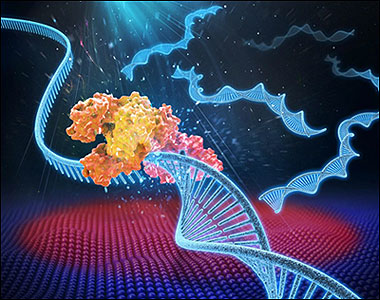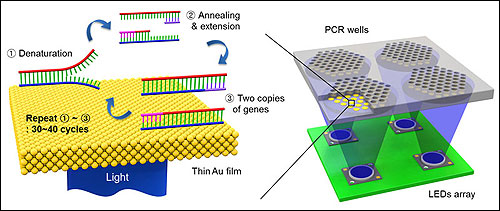An advanced thermal cycling system developed at the University of California, Berkeley (UC Berkeley), is expected to expand clinical and research applications associated polymerase chain reaction (PCR) tests.
The technology has shown itself to be far more efficient and practical in its acceleration of the heating and cooling of genetic samples — and it does so all with the switch of a light.
Contrasted to current PCR testing methods, which can take more than an hour to produce results, the new device has achieved PCR test results in mere minutes. 
An artist's rendering of photonic PCR on a chip using
light to rapidly heat and cool electrons at the surface of a thin film of gold.
This method promises to
transform point-of-care diagnostics in fields such as medicine, food
security and evolutionary biology. Courtesy of Luke Lee's BioPOETS lab.
Using LEDs, the UC Berkeley researchers were able to heat electrons at the interface of thin films of gold and a DNA solution. They clocked the solution’s heating speed at approximately 55 °F per second. The cooling rate was clocked at about 43.9 °F per second.
The PCR test amplifies a single copy of a DNA sequence to produce anywhere between thousands and millions of copies. It has become vital in genomics applications that range from cloning research to forensic analysis to paternity tests. PCR also is used in the early diagnosis of hereditary and infectious diseases and in analyzing ancient DNA samples.
According to Luke Lee, codirector of the Berkeley Sensor and Actuator Center and professor of bioengineering, “PCR is powerful and it is widely used in many fields, but existing PCR systems are relatively slow. It is usually done in a lab because the conventional heater used for this test requires a lot of power and is expensive,” he said. “Because it takes an hour or longer to complete each test, it is not practical for use for point-of-care diagnostics. Our system can generate results within minutes.”
To increase the rate of thermal cycling, Lee and his team leveraged the use of plasmonics, or the interaction between light and free electrons on a metal surface. When exposed to light, the free electrons are excited and begin to oscillate, which generates heat. Once the light is turned off, the oscillation and subsequent heating stop.

Gold is a popular choice for plasmonic photothermal heating because it is very efficient at absorbing light. As it also is inert to biological systems, it can be used in biomedical applications, as well.
Consequently, the researchers used thin films of gold that were 120 nm thick, or approximately the width of a rabies virus. The gold was deposited onto a plastic chip with microfluidic wells in order to secure the PCR mixture with the DNA sample.

Schematic showing the ultrafast photonic PCR. Thermal cycling is needed to separate the double-stranded DNA (left). Complementary
bases bind to the single strand (right). Courtesy of Jun Ho Son/UC Berkeley.
The light source was an array of off-the-shelf LEDs positioned beneath the PCR wells. The peak wavelength of the blue LED light was 450 nm and was tuned to get the most efficient light-to-heat conversion.
Through this approach, the researchers were able to cycle 30 times from 131 to 203 °F in less than five minutes.
In contrast, conventional PCR tests require repeated temperature changes — an average of 30 thermal cycles at three different temperatures — to amplify the genetic sequence; this is a time-consuming process that involves breaking up the double-stranded DNA and binding the single strand with a matching primer.
“This photonic PCR system is fast, sensitive and low-cost,” Lee said. “It can be integrated into an ultrafast genomic diagnostic chip, which we are developing for practical use in the field. Because this technology yields point-of-care results, we can use this in a wide range of settings, from rural Africa to a hospital ER.”
The research was funded by the Bill and Melinda Gates Foundation and the National Research Foundation of Korea.
For more information, visit: www.berkeley.edu.